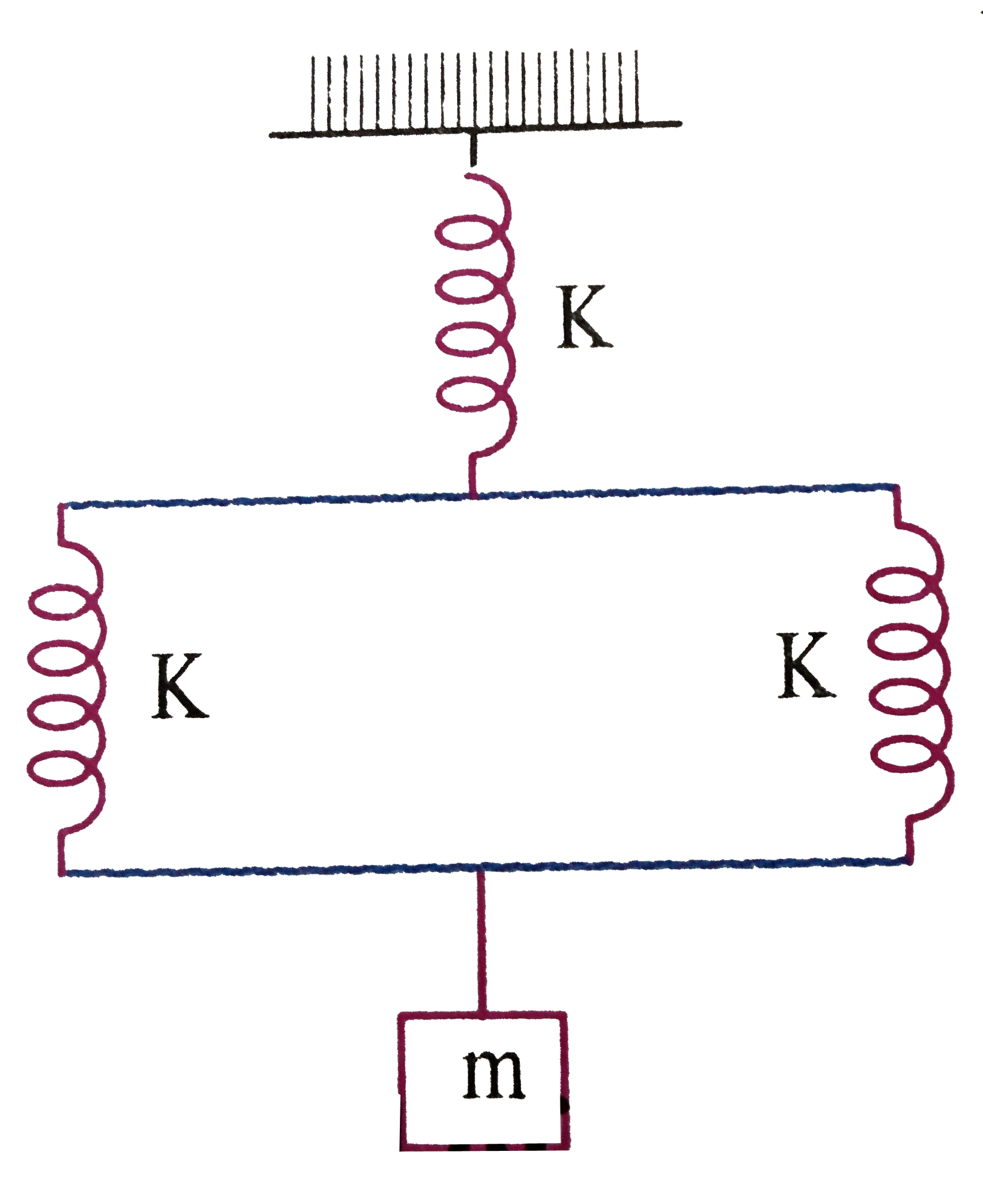A body of mass 1kg suspended an ideal spring oscillates up and down. The amplitude of oscillation is 1 metre and the periodic time is 1.57 second. Determine.
Maximum speed of body.
Maximum kinetic energy
Total energy
Force constant of the spring.
The correct Answer is:A, D
To solve the problem step by step, we will determine the maximum speed, maximum kinetic energy, total energy, and the spring constant of the system.
Given Data:
- Mass (m) = 1 kg
- Amplitude (A) = 1 m
- Periodic Time (T) = 1.57 s
Step 1: Calculate the Angular Frequency (ω)
The angular frequency (ω) can be calculated using the formula:
ω=2πT
Substituting the value of T:
ω=2π1.57≈4 rad/s
Step 2: Calculate the Maximum Speed (V_max)
The maximum speed (V_max) in simple harmonic motion is given by:
Vmax=A⋅ω
Substituting the values of A and ω:
Vmax=1⋅4=4 m/s
Step 3: Calculate the Maximum Kinetic Energy (KE_max)
The maximum kinetic energy (KE_max) can be calculated using the formula:
KEmax=12mV2max
Substituting the values:
KEmax=12⋅1⋅(4)2=12⋅1⋅16=8 J
Step 4: Calculate the Total Energy (E_total)
In simple harmonic motion, the total energy (E_total) is equal to the maximum kinetic energy (since potential energy is zero at maximum speed):
Etotal=KEmax=8 J
Step 5: Calculate the Spring Constant (k)
The spring constant (k) can be calculated using the formula for the time period:
T=2π√mk
Rearranging the formula to find k:
k=4π2mT2
Substituting the values:
k=4π2⋅1(1.57)2≈16 N/m
Summary of Results:
- Maximum Speed (V_max) = 4 m/s
- Maximum Kinetic Energy (KE_max) = 8 J
- Total Energy (E_total) = 8 J
- Spring Constant (k) = 16 N/m
- Mass (m) = 1 kg
- Amplitude (A) = 1 m
- Periodic Time (T) = 1.57 s
The angular frequency (ω) can be calculated using the formula:
ω=2πT
Substituting the value of T:
ω=2π1.57≈4 rad/s
The maximum speed (V_max) in simple harmonic motion is given by:
Vmax=A⋅ω
Substituting the values of A and ω:
Vmax=1⋅4=4 m/s
The maximum kinetic energy (KE_max) can be calculated using the formula:
KEmax=12mV2max
Substituting the values:
KEmax=12⋅1⋅(4)2=12⋅1⋅16=8 J
In simple harmonic motion, the total energy (E_total) is equal to the maximum kinetic energy (since potential energy is zero at maximum speed):
Etotal=KEmax=8 J
The spring constant (k) can be calculated using the formula for the time period:
T=2π√mk
Rearranging the formula to find k:
k=4π2mT2
Substituting the values:
k=4π2⋅1(1.57)2≈16 N/m
- Maximum Speed (V_max) = 4 m/s
- Maximum Kinetic Energy (KE_max) = 8 J
- Total Energy (E_total) = 8 J
- Spring Constant (k) = 16 N/m
Topper's Solved these Questions
- BOOK - ALLENCHAPTER - SIMPLE HARMONIC MOTIONEXERCISE - Exercise-04 [B]105videos
SIMPLE HARMONIC MOTION
- BOOK - ALLENCHAPTER - SIMPLE HARMONIC MOTIONEXERCISE - Exercise-05 [A]39videos
SIMPLE HARMONIC MOTION
- BOOK - ALLENCHAPTER - SIMPLE HARMONIC MOTIONEXERCISE - Comprehension Base Questions (5)3videos
SIMPLE HARMONIC MOTION
- BOOK - ALLENCHAPTER - RACEEXERCISE - Basic Maths (Wave Motion & Dopplers Effect) (Stationary waves & doppler effect, beats)24videos
RACE
- BOOK - ALLENCHAPTER - TEST PAPEREXERCISE - PHYSICS4videos
TEST PAPER
Similar Questions
A body of mass m suspended from an ideal spring is executing simple harmonic oscillations. The force constant of the spring is k and the time period of the body is T. Show by dimensional method that the formula T=2πm/k is incorrect. Establish its correct form.
View SolutionA body of mass 2 kg suspended through a vertical spring executes simple harmonic motionof period 4s. If the oscillations are stopped and the body hangs in equillibrium, find the potential energy stored in the spring.
View Solution
Knowledge Check
- Question 1 - Select One
The kinetic energy of a particle, executing S.H.M. is 16 J when it is in its mean position. IF the amplitude of oscillation is 25 cm and the mass of the particle is 5.12 Kg, the time period of its oscillations is
Aπ/5 secB2πsecC20πsecD5π sec
Mass suspended to a spring is pulled down by 2.5 cm and let go. The mass oscillates with an amplitude of
View SolutionA body of mass m is suspended from vertical spring and is set into simple harmonic oscillations of time period T. Next the spring is fixed at one end on a smooth horizontal table and same body is attached at the other end. The body is pulled slightly and then released to produce horizontal oscillations of the spring. The time period of horizontal oscillations is
View SolutionA body of mass m is suspended from three springs as shown in figure. If mass m is displaced slightly then time period of oscillation is
 View Solution
View SolutionA block of mass M suspended from a spring oscillates with time period T. If spring is cut in to two equal parts and same mass M is suspended from one part, new period os oscillation is
View SolutionA block of mass M suspended from a spring oscillates with time period T. If spring is cut in to two equal parts and same mass M is suspended from one part, new period os oscillation is
View Solution
A block of mass m is suspended from a spring and executes vertical SHM of time period T as shown in Fig. The amplitude of the SHM is A and spring is never in compressed state during the oscillation. The magnitude of minimum force exerted by spring on the block isView SolutionA mass m is suspended from a spring of force constant k. The period of oscillation is T0 The spring is cut into 4 equal parts: The same mass m is suspended from one of the parts. What is the new period?
View Solution

